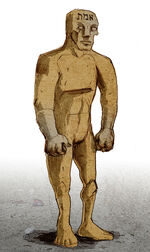
Modern depiction of a golem by fantasy artist Philippe Semeria. The Hebrew word for "truth" is written on the golem's forehead.
A golem is a monstrous being in Jewish folklore. It is a figure in the form of a man which is made of inanimate material, usually clay, that can be brought to life by a rabbi. A golem is supposed to do everything that its creator commands it to do, although there are stories of golems turning on their creators and becoming uncontrollably violent. Although they usually start out as unthinking robot-like beings, in some stories, golems develop thoughts and emotions similar to those of people.
The manner in which a rabbi brings a golem to life varies from story to story. In some stories, the rabbi needs to write a series of Hebrew characters on a piece of parchment which he places in the golem's mouth. In other versions of the legend, the golem is activated by having the Hebrew word emet, meaning truth, written on its forehead. To deactivate the golem, one character is erased, leaving the word met, Hebrew for death, left on its forehead.
Much like traditional zombies in Haitian folklore, golems are usually depicted as carrying out all commands that their masters give them without question. The commands may need to be written on parchment and placed in the golem's mouth or may simply be spoken. Instructions given to a golem usually have to be very clear and specific and a golem will usually carry on performing the same task until it is ordered to stop. For example, if a golem is given the command, "Fetch water from the river and pour it on the kitchen floor", if it is not told to stop, it will pour bucket after bucket on the floor, quickly flooding the house and eventually causing the river to run dry. A golem may misunderstand its commands and do things that its creator did not intend it to do, often with disastrous consequences.

Depiction of Rabbi Loew and the Golem of Prague.
The most famous golem legend is that of the Golem of Prague. The legend states that in the 16th century, the Holy Roman Emperor ordered that all Jews be expelled from Prague or killed. Rabbi Juddah Loew ben Bezalel created a golem to defend his people. The golem was so successful at striking fear into the hearts of the imperial troops that the Emperor pleaded with Rabbi Loew to deactivate it. The rabbi agreed, on condition that the Emperor promised to stop persecuting the Jews. The deactivated golem was kept in storage, the Emperor knowing that it would be brought back to life if he broke his promise. Some versions of the legend say that the Golem of Prague became uncontrollable, indiscriminately killing Jews and non-Jews alike. It is sometimes said to have turned violent after a woman rejected its advances.
Stories of golems may have inspired Mary Shelley's 1818 novel about the creation of an artificial man, Frankenstein. It has been suggested that the word "golem" is the origin of the name of the character Gollum from J.R.R. Tolkien's The Hobbit and The Lord of the Rings, although the character bears little resemblance to the golem of folklore.
